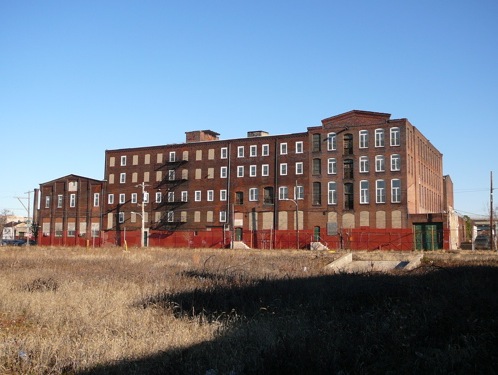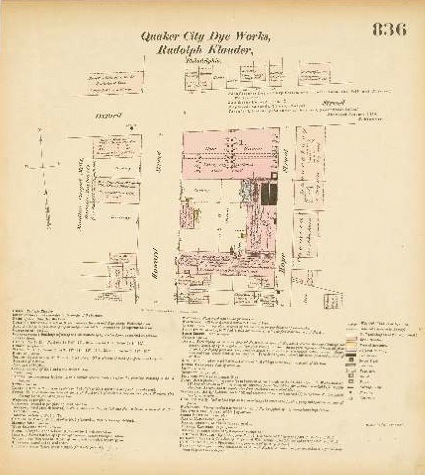
West facade along Howard Street (2007).
Quaker City Dye Works, 1875
100-110 West Oxford Street, Philadelphia PA 19122
(occupies most of the block bounded by Oxford, Front, Howard, and Jefferson Streets—except for the houses along Jefferson Street)
© Carmen A. Weber, Irving Kosmin, and
Muriel Kirkpatrick, Workshop of the World (Oliver Evans
Press, 1990).
A Hexamer General Survey placed the
dyeworks, with owner Rudolph Klauder, on this corner in
1875. 1
Already there were
associated chemical laboratories to the east across Hope
Street, although at this time they were only one story.
The firm manufactured dye, cotton and woolen yarns, and
silk. At that time some space in the building was used by
a firm across Howard Street, Monitor Carpet Mills, of
Dornan, Maybin and Co., for storing carpets. In 1880
Blodget stated that silk dyeing was part of the regular
work of this "large establishment." 2
By 1883 Quaker City was the
largest dyeworks in the city, with three and four story
brick buildings extending to Front Street and employing
over 200 persons. 3
Textile work in Philadelphia was always diverse, with
many workers employed in specialty operations distinct
from weaving such as hosiery and carpet manufacturing,
spinning, and dyeing and finishing yarns and fabrics. The
number of firms in the dyeing and finishing sector of the
textile business was exceeded only by firms producing
carpets, or hosiery, or cotton and wool goods. In 1882
there were 192 carpet manufacturers, 59 hosiery
producers, and 44 dyers and finishers in
Kensington. 4
In 1895 Quaker dyeworks was still in business at this
location but the ownership may have changed; in 1892
Klauder and Brother had a smaller dyeworks in Kensington
proper. 5
By 1910 the operations and
ownership definitely had changed; the Bromley atlas noted
an O'Neill Bros. Woolen Mill on the site, but their main
product was waste textile materials. 6
In 1916 the O'Neill Bros.
firm employed ninety people, they operated only the mill
buildings, the laboratory of the dye works became the
Oxford Mills, a carpet firm. In 1945, the firm continued
to occupy the site manufacturing the same product, and
the number of employees increased from eighty-nine in
1940 to one-hundred-twelve in 1943. 7
O'Neill Bros. goes back to 1891 where a Hexamer insurance
map located them at the triangular property formed by
Columbia Avenue, and Putnam and Howard Streets, one block
north of what was the Quaker City Dyeworks. Here they
were producing shoddy and waste, before moving to the
larger mill. Shoddy is waste wool, recovered from textile
operations, with enough fiber length to make use of it
again; mungo is a similar product of a shorter fiber, and
therefore lower quality.
Today all buildings are occupied by Pieri Creations.

1 Hexamer General Survey #836 (1875) "Quaker
City Dye Works, Rudolph
Klauder."
2 Blodget, The Textile Industries of
Philadelphia, p. 50.
3
Blodget,
Census of
Manufactures,
p. 67.
4
Scranton,
Proprietary
Capitalism, p.
321, Table 9.1.
5
Hexamer General Survey #2631 (1892)
"Klauder & Brothers Dye
Works."
6
Bromley, 1910.
7
Chamber of Commerce
and Board of Trade, Philadelphia, p. 42; and, Sanborn Map
Company, 1945.
Update May
2007 (by Torben
Jenk):
Pieri Creations made and imported lamps and lamp shades.
A recent Zoning Notice stated "To create 1 lot from 19,
demolish a one-story addition, build 42 dwelling units in
building #1, build 48 dwelling units in building #2, 90
dwelling units total, 76 open-air parking spaces, none
for handicap."